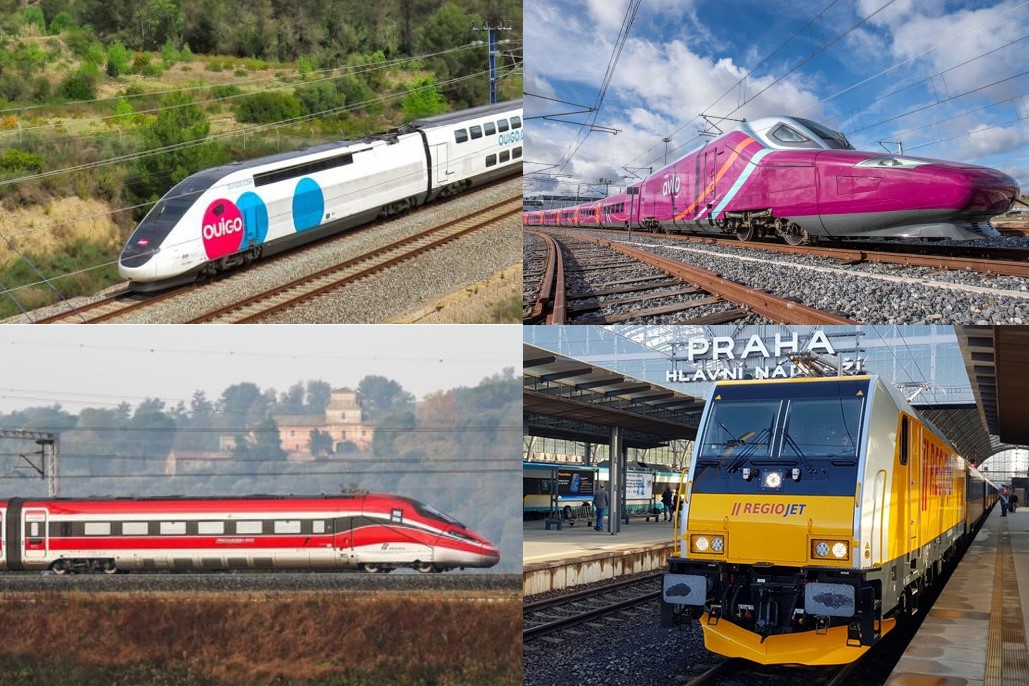By Frédéric de Kemmeter – Railway signalling and freelance copywriter – Suscribe my blog
14/11/2021 – (Version en français)
🟧 Back to homepage 🟧 See our brief news
COP26 in Glasgow is over, but the race to decarbonise the transport sector has long been on. In this great game, the train can find its place if it manages to demonstrate its relevance.
The pressure on governments and corporations to push on with the adoption of low-carbon technology is only going to increase. In the transport sector, the urge to decarbonise is manifesting itself in an increasingly frenetic push for the roll-out of hydrogen fuel cell and battery technology to replace internal combustion in everything kind of vehicle, including aircraft. As part of its ‘Fit for 55’ package of climate legislation, the European Commission put forward several ways of boosting the use of renewable hydrogen. That has whetted the appetite of many industries, seeing the arrival of good business, notably Alstom.
Rail seems to have the great advantage that it is already partially electrified. However, 45 per cent of Europe’s rail network is not still electrified. In addition, diesel traction and high levels of noise that it causes are now become the unacceptable face of rail, in particular in the UK, Ireland, Canada and in the USA. For some local residents, it is becoming increasingly difficult to promote the train as a low-carbon alternative in such circumstances. The problem is that this message is being received 5/5 by elected politicians. At the same time, they are receiving other decarbonisation proposals, mainly from the automotive sector. Intense lobbying is trying to keep the road sector, rail’s main competitor, in the starting blocks of the decarbonised future.
New technologies
Can rail stay in the race? Today, bi-mode electro-diesel and battery-electric trains are already reducing diesel operation ‘under the wires’ on partially electri ed routes, while batteries and supercapacitors are making inroads in urban rail applications. There is no doubt that the weight of the batteries, the main technical problem when adding them to an existing train, will decrease as technology improves.
The enthusiasm for hydrogen is tempered by the way the fuel is created. The process to create ‘green hydrogen’ by electrolysis can be seen as ‘a wasteful use of electricity’. According some experts, a hydrogen train uses 3.5 times as much electricity because of inefficiencies in the electrolysis process and also in the fuel cells. However, there is no doubt hydrogen will work in the future in some case.
But the decarbonisation of transport also means that the rail sector will have to work hard to accelerate its modernisation if it is to appear to be the best solution to the politicians. At present, it is bitterly obvious that every technological advance on a train is accompanied by a mountain of procedures that can sometimes slow down the progress that was hoped for. The railways are still too often presented as a dangerous tool to exploit compared to other modes. Yet how many people die on the road each year?
In addition, there are still national positions that can handicap the train. This is the case with the famous freight car brake blocks, designed to make less noise but which suddenly become a risk object in some countries. We can also expect a nice stack of procedural barriers for the future operation of the automatic coupling for freight wagons. There are many other examples of why the railways are struggling to make progress. It is 30 years since the ERTMS concept was launched. There is still a lack of hindsight to make an initial assessment of Alstom’s hydrogen trains in Germany, which were launched in 2018 thanks also to strong support from public authorities. Would this technology be viable with less subsidy? Remember the debate on wind turbines and the high subsidy of this sector compared to the expected results…
Service and infrastructure
Of course, technology will not solve all problems. Decarbonisation is also about attracting people to the train rather than letting them use a polluting mode. So we also need to invest in the service we provide to passengers, and ask them what they really want to use the train for. On-board wifi and ticketing facilities seem to top the list. Making the train journey a useful time for work is also a highly sought-after criterion, especially by customers with high purchasing power. However, ensuring an uninterrupted mobile connection on board trains brings us back to technology once again, and here too we are seeing the emergence of various solutions, unrelated to hydrogen or battery-powered trains.
Decarbonisation also means ensuring better traffic flow, which leads us to the field of infrastructure. We may not be obliged to carry out major luxury works, but in certain places, a complete reconstruction is necessary and requires significant public funds. Let’s not forget that investments that seem costly today will save us from other equally costly expenses for the next 50 years.
Last but not least, decarbonisation is about the quality of the operators who run the trains. While we can denounce the mountains of procedures, we must not forget that they have arisen as a result of sometimes serious failings on the part of some. The quality and follow-up of procedures should not be a question of money but the guiding principle for any carrier. There is no room for either technical dumping or procedural mountains, but a fair balance must be found between these two extremes.
It is all of these conditions that will make rail a solution for achieving each country’s climate objectives. Let us pray for less procedural mountains and more best practice. The train cannot be « a dangerous tool to exploit » but an exemplary decarbonisation tool.

14/11/2021 – By Frédéric de Kemmeter – Railway signalling and freelance copywriter
Suscribe my blog
Related topics:
 No intelligent train without infrastructures
No intelligent train without infrastructures
07/11/2021 – It is sometimes believed that the intelligent train would be enough to solve some of the problems of railway operations. However, this train will have no impact without the infrastructure that accompanies it.
 Which future for hydrogen-propelled trains?
Which future for hydrogen-propelled trains?
02/08/2021 – Can hydrogen trains make it possible to avoid railway electrification? It all depends, and many questions remain to be answered. A brief overview
 Is automatic coupling on freight wagon will become reality?
Is automatic coupling on freight wagon will become reality?
09/07/2020 – Europe is finally testing an automatic coupling for its freight trains. But now with digital attributes. This coupling will make it possible to operate « intelligent trains »
 Can the train really replace the plane?
Can the train really replace the plane?
28/06/2021 – The train could replace some 500 to 1000km flights. Mentalities seem to be evolving in this direction and the average travel time would increase. But there are still a number of conditions for this replacement. xxxxxxxxxxxxxxxxxxxxxxxxxxxxx xxxxx xxxxxxxxxx xxxxxxxxxx xxxxxxxxxxx
 What’s new about long distance operators?
What’s new about long distance operators?
22/08/2021 – There is a lot of movement among the long-distance operators in Europe. This is an opportunity for a brief summary as we enter the last quarter of 2021, featured Trenitalia, Ouigo Espana, REgioJet and Renfe. xxxxxxxxxxxxxxxxxxxxxxxxxxxxx xxxxx xxxxxxxxxx xxxxxxxxxx xxxxxxxxxxx
 Moving from product to customer: can rail learn from Gafam?
Moving from product to customer: can rail learn from Gafam?
20/06/2021 – Moving from a « product » policy to a « customer » policy is a real challenge for rail. The weight of assets (trains-infrastructure) and cultural habits still largely shape rail policy, but there are, however, some reasons for hope.
 What have you done with the railways in recent decades?
What have you done with the railways in recent decades?
04/05/2021 – « The market share of rail has not increased despite liberalization, » said the Portuguese minister. Why? This is explained in this article. xxxxxxxxxxxxxxxxxxxxxxxxxxxxxxxxxxxxxxx xxxx


Vous devez être connecté pour poster un commentaire.